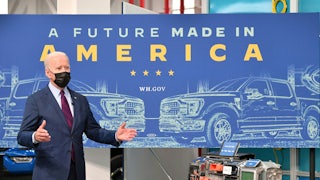Scandinavia has long been looked at admiringly by democratic socialists in the United States for its generous welfare state. In the last few years, Norway in particular has gained attention from climate advocates for its remarkable success swapping internal combustion engine–powered cars for electric vehicles, which now account for 54 percent of new car sales; just 8 percent of new cars sold are powered only on conventional gasoline or diesel. There was even a Super Bowl ad about it. An impressive array of state support—from exemptions on everything from tolls and parking fees to considerable new car taxes that account for roughly 19 billion Norwegian kroner ($2.16 billion) per year—has driven this transition. (Police, for reference, get about 22 billion kroner annually.)
But there’s a tension here: Like other aspects of Norway’s welfare state, these programs are underwritten by the country’s enormous oil wealth. Though Norway’s domestic economy is well on its way to decarbonization, the economy is still heavily dependent on petroleum exports from offshore rigs in the North Sea, via its state-owned oil company, Equinor, and expansive social wealth fund—a major point of contention in national elections held there last September; Greens calling for a phaseout failed to make it into the minority center-left governing coalition.
Ironically, the fact that the U.S. allows its oil producers to hoard profits gives it at least one significant advantage in the energy transition over Norway: It may well be easier for us to stop exporting huge quantities of oil. The benefits of extraction exports here aren’t nearly as widespread as they are in other oil-producing nations, in part because the way the U.S. encourages drilling is by effectively paying companies public money to accumulate private wealth. So while fossil fuel executives and their lobbyists are a political force to be reckoned with, the fact that the U.S. has a relatively diversified economy that captures almost no natural resource wealth makes it easier—at least in some technical sense—to imagine a thriving economy that doesn’t send prodigious amounts of emissions to be burned abroad. The problem is that decades of allowing extractive industries to amass money and power have made it nearly impossible to imagine placing reasonable constraints on them, whether in sending fuel abroad or limiting demand at home.
Petroleum accounts for 49 percent of Norwegian exports, compared to roughly 10 percent in the U.S. But Norway and the U.S.—the world’s top oil producer, making over two million more barrels per day than Saudi Arabia—handle their oil wealth very differently. Unlike in Norway, whose $1 trillion “Oil Fund” is invested broadly and helps furnish a generous welfare state, relatively little of America’s natural resource wealth goes toward the public. In general, profits line the pockets of shareholders and allow companies to mount sizable lobbying operations that can push for them to pay even less in taxes. Nine U.S. oil and gas producers paid no federal taxes at all in 2018. Chevron even got a $181 million rebate from the IRS. The Trump tax cuts saved just 17 oil companies $25 billion in taxes; ExxonMobil saw an immediate benefit worth $5.9 billion, and (alongside other extractive companies) mounted an impressive lobbying offensive against tax provisions in Build Back Better. To the extent that the U.S. has a welfare state, it is not being furnished by oil wealth.
Crude oil exports are also a relatively recent development in the U.S., having exploded after 2015, when—just days after the Paris Agreement was brokered—temporary tax credit extensions for renewables were swapped for the repeal of a long-standing statute that had mostly banned the practice. Exports shot up 750 percent over the following four years despite domestic demand staying roughly flat. As gas prices have risen over the last few months, the administration at one point mulled reinstating the crude oil export ban. Energy Secretary Jennifer Granholm took that option off the table in December, telling the country’s biggest oil and gas producers, “I do not want to fight with any of you.” The U.S. only began exporting liquefied natural gas, or LNG, in 2016, and just recently became the world’s biggest LNG exporter thanks to authorizations from the Energy Department. Both LNG and crude oil exports could be stopped without Congress.
Export bans were lifted in the U.S. because the fossil fuel industry wanted to make profits abroad, and are now off the table for the same reason. Limiting exports wouldn’t solve the problem of oil consumption, of course: Despite having just over 4 percent of the world’s population, the U.S. consumes 20 percent of its oil, roughly equal to the share that it produces. But there’s plenty to be learned from Norway when it comes to domestic fossil fuel consumption, as well—though it’s not all about incentives.
Norway levies high taxes on gasoline, and the new center-left minority
government plans to triple its long-standing national carbon tax. Historically cheap and clean electricity, provided through publicly owned renewable hydropower that meets more than 90 percent of electricity demand, has made electric-powered cars an attractive and genuinely green alternative. Biden’s Build Back Better Agenda currently lacks any such sticks on carbon-intensive fuels, now that Senator Manchin has killed the Clean Electricity Payment Program: Without a means of greening the entire energy grid, many of the electric vehicles that Biden’s plan would add might well still be fueled via gas- and coal-fired power plants. While life-cycle emissions for E.V.s charged by gas-fired power are still lower overall than for cars that run on oil, this would limit the benefit of switching to E.V.s.
Widespread social benefits—and the hard-won idea that a government is responsible for providing a certain quality of life to the people who live in a country—can also help protect households against energy market volatility. To note, this isn’t a fluke of having oil reserves: Norway’s neighbors—Sweden, Finland, and Denmark—provide generous public amenities to their residents, too. Though electricity is generally cheap in Norway, the country has been in the process of integrating its power sector with Europe’s via undersea cables. That’s made it vulnerable to the energy price spikes that have rocked the continent the last few months and are now causing electricity prices to surge. On Saturday, the government announced it would boost support to households to cover electricity, paying 80 percent of bills over 0.7 Norwegian kroner ($0.08) per kilowatt hour through March. Unlike the U.S., Norway has an expansive public transit system, meaning that fewer people rely on cars to get to and from work, school, and weekend outings, in towns and cities generally designed for people, not cars.
Despite the outsize role electric vehicles have played in the White House’s green spending plans—Biden even took time out this November to test drive an E.V. Hummer—its E.V. policy dreams are comparatively modest: The bipartisan infrastructure bill spends just $7.5 billion on incentives for electric vehicle charging—much less than what’s needed to meet its own goals for E.V. deployment, according to the consultancy AlixPartners. Should it pass, the Build Back Better Act is slated to provide consumers up to $12,500 off a new car.
Mostly, the White House spending proposals envision greening today’s quality of life: populating today’s congested highways with E.V.s instead. And the administration has shied away from direct limits on polluters. Building a genuinely sustainable society—let alone one doing its part to cap warming at 1.5 degrees Celsius (2.7 degrees Fahrenheit)—means thinking a lot bigger and picking fights. American liberals are used to envisioning Scandinavia as light years ahead of the U.S. But whatever the fate of Build Back Better and legislative incentives for E.V.s, the Biden administration has the opportunity to “crush those lugers”—in the words of GM’s bizarrely charming 2021 Super Bowl ad—in one important part of the climate policy arena: Stop exporting carbon.










